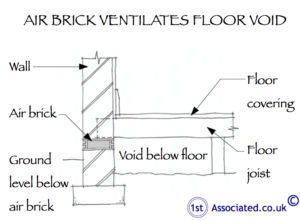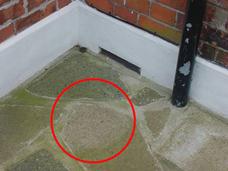Dampness and Sloping Sites
Help and advice with regards to building problems
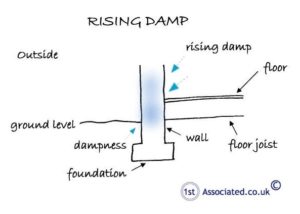
We carry out lots of building surveys and structural surveys which highlight problems within properties, many of which relate to dampness. Over the years we have been involved with all sorts of dampness problems from rising damp to lateral damp, dampness caused by capillary action, interstitial condensation and many condensation problems and black mould.
We are happy to carry out specific defect reports which are designed to specifically help solve these problems so if you have any problems with any of these please do not hesitate to contact us on 0800 298 5424.
We also can provide help and advice with regard to building surveys, structural surveys, independent valuations, property surveys, structural reports, engineers reports, home buyers reports or any other property matters .
We use lots of sketches and photos in our building surveys
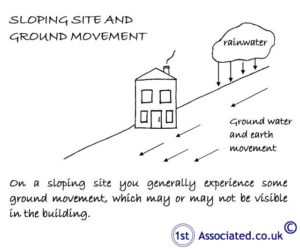
As you can see from this article we use lots of sketches and photos in our reports as the feedback we have from our clients is that the sketches and photos help them understand the reports.
Meet the building surveyor at the property
Buying a new property is likely to be one of the most expensive if not the most expensive purchase that you ever make which you will be repaying for many years to come therefore if you have time we would always recommend that you meet the surveyor at the property during the survey to discuss further any issues you have and also for us to show you what we have found.
We like to talk through the survey either at the survey or after the survey so we are more than happy to talk to you on the phone. Please call us on free phone 0800 298 5424 for a friendly chat.
Sloping Site Problems
During our building surveys and structural surveys we are frequently coming across problems due to properties being built on sloping sites. As rainwater wants to travel from the top of the site to the bottom of the site and the property is in the way the rainwater effectively passes through the property causing dampness. In many cases there is no defined route around the property for any rainwater travelling down through the garden . In the case of the photographs below the ground has been raised and altered and in the second photograph it has been stepped.
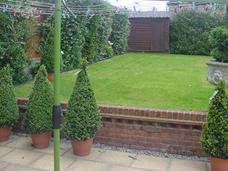 |
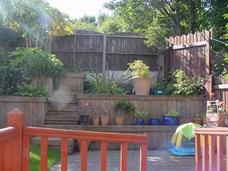 |
|
Raised sloping site |
Stepped sloping site |
We generally recommend that the next time it rains heavily that you stand outside the property and see how the rainwater gets around the property.
Ground Movement on a sloping site

Any property on a sloping site is more susceptible than one on a flat site; it is simply the laws of gravity.
Foundations normally allow for such occurrences, particularly in new properties.
There can still be some minor movement as illustrated by the sketch.
French Drains and running gulleys
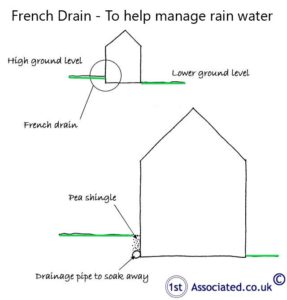
There are numerous different ways to help the rainwater get around the building in a more organised controlled manner such as French Drains, but more about this later.
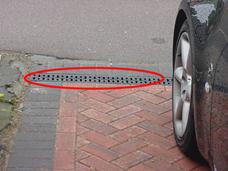 |
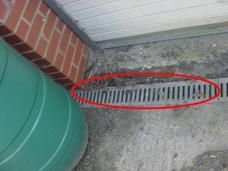 |
|
Example of a running gulley |
Running gulley |
Dampness caused by sloping sites
If rainwater is allowed to discharge against a property then dampness will occur. As you can see in the photographs below mould and moss are visible to the stonework and rot is occurring to the base of the door.
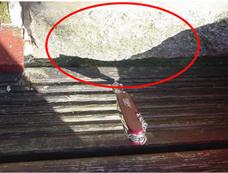 |
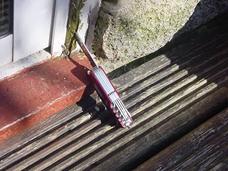 |
|
Mould on stonework |
Rot to base of doors indicates that rainwater is going into the building rather than around it |
The rainwater needs to be diverted away from the property in the form of a French drain or running gulley.
In this case, the property was on a sloping site where rainwater was discharged towards the front of the house causing mould to the brickwork.
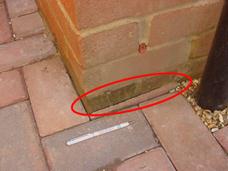 |
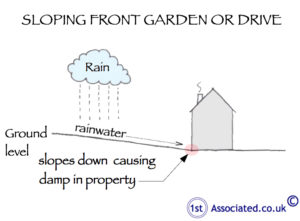 |
|
Mould occurring to base of brickwork |
Sloping front garden |
Our surveyors have often come across problems caused by sloping sites when carrying out surveys. You can see many cases on our website, for example:
Specific Defects Report for Hampshire
French Drains
Cracks to my plaster, is it a structural problem?
Whats do surveyors do?
Rising damp or is it?
How can you reduce the dampness caused by sloping sites?
It is difficult to solve the issues caused by sloping sites but there are things you can do to help the situation such as adding a French drain or running gulley.
French Drains
We have already touched upon the use of French Drains. In many cases we recommend a French Drain is added, which acts as an area to take away rainwater that is directed at that area allowing rainwater to pass around the building rather than through it. A French Drain can be a DIY job where a trench is dug around the property with a perforated drainage pipe and topped with pea shingle. The drainage pipe should be wrapped in a filter fabric to reduce blockages and the pipe should have a fall to the drain.
|
|
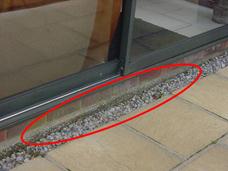 |
|
French Drain |
Example of a French Drain. |
Is it a proper French Drain?
It is important that it is a proper French Drain and not just one for decorative purposes which we often come across. We have literally dug these up to find that there is no drain in them.
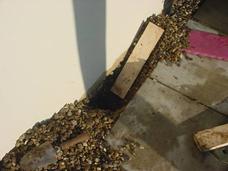 |
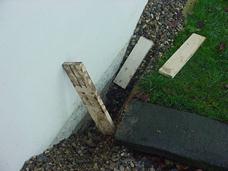 |
|
A French drain which we dug up which wasn't a proper French drain |
A false French Drain |
Retaining walls

As we mentioned earlier on a sloping site rainwater wants to travel from the top of the site to the bottom of the site.
Retaining walls can be added to limit this with weep holes to reduce the water/ground pressure.
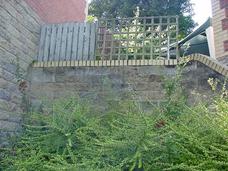 |
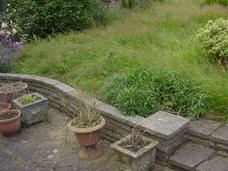 |
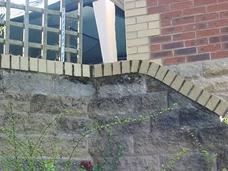 |
|
Retaining wall |
Small retaining wall |
Moss appearing on brickwork and top of stone of retaining wall |
Weep holes
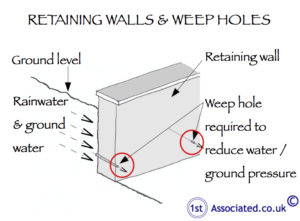
Retaining walls require weep holes to allow rainwater to pass through the wall rather than build up pressure behind it.
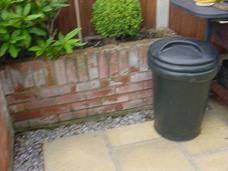 |
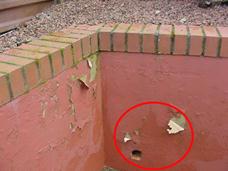 |
|
Retaining wall - salts getting through – needs weep holes |
Weep holes to retaining wall |
Airbricks acting as gutters
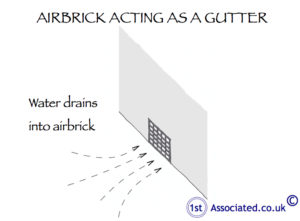
If you own a property on a sloping site you should ensure that the low level airbricks do not act as gutters as the rainwater flows towards the building allowing rainwater into the building and causing dampness.
Airbricks can be protected as illustrated in the sketch.
|
|
|
|
Airbrick acting as a gutter |
High paving slab - Airbricks acting as gutters |
In the below photograph you can see that the airbrick has been protected but we don't believe that the kerb stone is allowing sufficient space to allow airflow underneath the property. The principle of what they have done we agree with, i.e. protecting the airbrick from acting as a gutter however in a suspended timber floor as in this case, airbricks are essential to have a through flow of air as this helps to reduce the chances of wet rot, dry rot and woodworm.
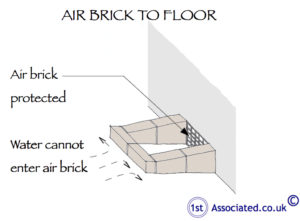 |
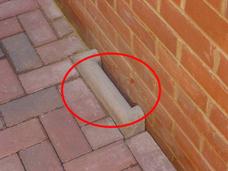 |
|
Protected airbrick |
Protected airbrick |
Sloping site discharging rainwater onto the main road
We recently surveyed a property on a slightly sloping site where rainwater discharged onto the road. As we understand it, you are liable if there is a problem where you discharge water onto the main road. In this case, we recommended a running gulley was added at the base of the drive.
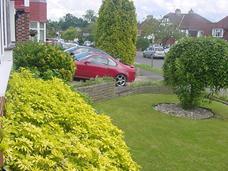 |
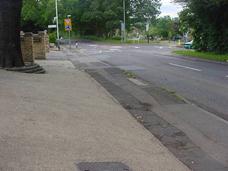 |
|
Front garden on sloping site |
Driveway discharges water onto road |
Dry lining hiding dampness
In some cases we are unable to check dampness within a property properly due to the dry lining.
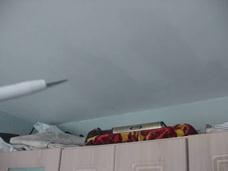 |
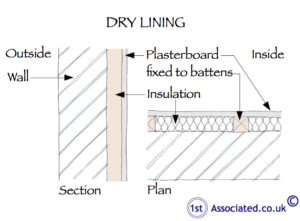 |
|
We were unable to check for dampness due to dry lining. Note: also repainting of ceiling may be hiding dampness. |
Dry lining |
One last story on sloping sites
Once as a trainee surveyor many years ago we were involved in carrying out a refurbishment and design work on a restaurant for a corporate client and part of this work originally was to level the car park. Unfortunately budgets were cut and the car park was left as what we would describe as a sloping site. Unfortunately at the opening of the restaurant someone didn't put their car's handbrake on which led to it rolling into the adjacent very busy road. Sloping sites can be dangerous in many ways!
Independent Surveyors
If you truly do want an independent expert opinion from a building surveyor please contact us on 0800 298 5424 to have a free of charge friendly chat. We carry out valuations, building surveys, structural surveys, structural reports, engineers reports, specific defects reports, home buyers reports or any other property matters.
W e feel our surveys are quite unique, as they are written to your level of knowledge. The surveys include photos and sketches and definitions. The survey will also include an action required section and an estimate of costs in the executive summary. We are more than happy to meet you at the property whilst carrying out the survey to discuss any specific issues you may have or have a general chat about what we have found at the end of the survey.
Commercial Property
If you are looking for commercial property, whether it is freehold or leasehold, we would recommend a survey as this will prevent dilapidations claims in the long run. You may wish to look at our Dilapidations Website at www.DilapsHelp.com and for Disputes go to our Disputes Help site www.DisputesHelp.com , both of which we have been advised are very helpful!
We hope you found the article of use and if you have any experiences that you feel should be added to this article that would benefit others, or you feel that some of the information that we have put is wrong then please do not hesitate to contact us (we are only human).
The contents of the website are for general information only and is not intended to be relied upon for specific or general decisions. Appropriate independent professional advice should be paid for before making such a decision.
All rights are reserved the contents of the website are not to be reproduced or transmitted in any form in whole or part without the express written permission of www.1stAssociated.co.uk

